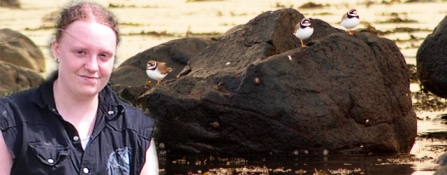
Background image © Barrri Williams
Image Title: Turnstone (Arenaria interpres) foraging for food amongst seaweed. Outer Hebrides, Scotland.
Credit: 2020VISION Image Collection

Background image © Barrri Williams
Instead of surfing or sunbathing, I would take pens and a book and disappear from the crowds past the breakwater.
On family camping holidays when I was a young teenager I used to wander off on my own at the beach for hours on end. Instead of surfing or sunbathing, I would take pens and a book and disappear from the crowds past the breakwater. In the blazing sun wearing stupidly baggy jeans and a black hoodie, I would find a comfortable rock far too close to the water to relax on. I would watch the clouds go by writing the kind of terrible poetry every 13 year old goth kid did, with the strange drawings to go with it. I’d listen to music constantly, but with the volume turned down so low I could always hear the ocean, the gulls flying overhead, or the chains rattle in harbour as the tractor hauled in the tiny fishing boats just feet away. Once or twice I watched people stranding themselves on the rocks opposite; a brave kayaker paddling round the headland towards the open Atlantic, or a small child being brought to see the giant rockpools that were hidden in this secluded area away from the white sands of the beach itself.
I always pictured them like small children, running towards the waves as they went out, then being surprised as the water turns and start chasing them the other way.
But every day I watched the turnstones. I always thought they were a bit stupid then. Round little spheres of birds, fat and tiny at the same time. It’s a surprise now to learn they’re on the amber list because I was so used to seeing them. Perfectly camouflaged except for their white bellies, they would pick a large granite boulder to sit next to for hours and rest; always so close to the ocean that any sudden change in the waves sent them running like mad, hopping rock to rock, trying to stay out of the foam. I questioned this behaviour so much at the time, without noticing that I would be doing the exact same thing.
I enjoyed being so close to the water, watching the waves ebb and flow, feeling the soft sea spray on my face when the wind was still gentle. I’d occasionally run away when it got too close to my notebooks, forcing me to jump rock to rock to escape the tide. The breeze was cool, there was no one around to disturb us, and it made a nice place to rest despite the occasional hazards. Sometimes a wave would retreat and the whole flock would run forwards as if chasing it back to the sea; a good way to pick up any insects that have been disturbed without having to chase them for long. I always pictured them like small children, running towards the waves as they went out, then being surprised as the water turns and start chasing them the other way. It’s easy to imagine that they were just having fun, enjoying chasing the waves as much as we might.
I understand now how much more energy it takes for birds to fly rather than walk, it had just never occurred to me before. Nor had the idea that if the birds needed to leave then I probably did too.
Eventually the little flock would get cut off by the tide and decide it was worth flying to avoid wet feathers, and I’d think they were stupid again to not have done it sooner. After all they’re birds so why not just fly? I understand now how much more energy it takes for birds to fly rather than walk, it had just never occurred to me before. Nor had the idea that if the birds needed to leave then I probably did too. Picking the highest rock to perch on gave me a great view of what the turnstones had been doing, and the water swirling around me on all sides. That’s when you get to decide if you’re getting your only pair of trainers salty or do you roll up your oversized jeans and wade barefoot because you can’t quite jump the full 2 meters to the next big rock that’s still dry. I quite clearly wasn’t as clever as the turnstones.